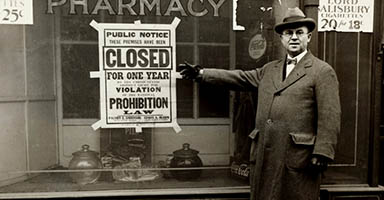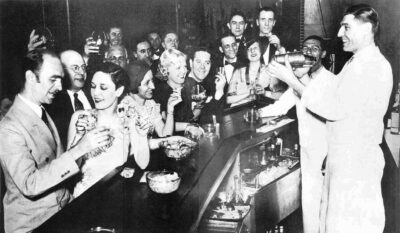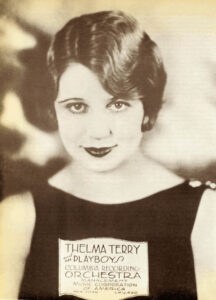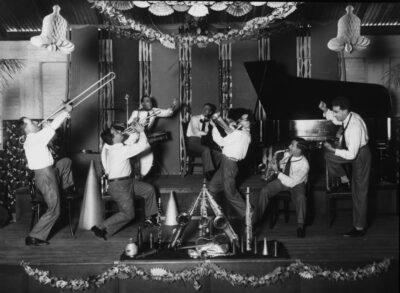Blog
Prohibition and Jazz

On January 17, 1920, the law prohibiting the sale and consumption of alcohol in public places went into effect in the United States: the Prohibition era had begun, and what would come to be known as the "Roaring Twenties"!
Thousands of saloons across the country were forced to close their doors, but the demand for alcohol showed no signs of abating, and soon thousands of illegal bars, or speakeasies, often run by gangsters, were opened, serving bootleg liquor. Inside them, to entertain customers, small bands of local musicians played jazz, music that fit well with the party atmosphere in these places. Thus it was that jazz became the new trend, and the soundtrack of the era.
This promoted the careers of important artists such as Louis Armstrong, King Oliver, Duke Ellington, Fats Waller, Paul Whiteman, Bix Beiderbecke, as well as jazz itself as an art form. The 1920s were thus also "the age of jazz" and that of the great dances that went with the new music, such as the "Black Bottom," the "Charleston," the "Fox Trot," the "Shimmy," "The Break-away," and the "Lindy Hop."
In August 1920, another federal law finally went into effect, granting women the right to vote. In fact, this was a giant step forward, and women began to divest themselves of nineteenth-century cultural conventions and become protagonists of social life in their own right. The so-called "flappers" of the Jazz Age became the most visible heroines of this rebellion: they cut their hair into the typical bob, wore short skirts or pants (which in some states were banned at all), smoked, drank, and frequented nightclubs and speakeasies, where jazz music was played, alcohol was consumed, and dancing was wild, showing off their bare legs and arms.

There are many examples of women becoming icons and breaking important gender barriers, such as Amelia Earhart, who in 1928 became the first woman to cross the Atlantic in a manned (male) flight.

Women also acquired a role in music and entertainment, as artists and sometimes as pioneers in the field. The first blues song sung, "Crazy Blues," was recorded just in 1920 by Mamie Smith. The record sold a million copies in the following months, opening the market to so-called "Race Records," records recorded by blacks, designed for a black audience, but which were also bought by large numbers of white admirers.
And speakeasies regularly featured a number of prominent female musicians, such as Lil Hardin, who played piano with King Oliver at Chicago's Dreamland; Thelma Terry, a double bass player and band leader (the first woman credited with leading an all-male orchestra), who worked steadily at Colosimo's Restaurant, owned by Al Capone; and Blanche Calloway, Cab's older sister, a singer and band leader who performed at Chicago's Ciro's with her own all-male orchestra.
In 1920 the first commercial radio stations went on the air, and soon the popularity of jazz skyrocketed thanks to the rise of record recording and the spread of music over the airwaves.
It is often said that speakeasies fostered integration, and this means that many black jazz musicians with Prohibition began to be called upon to entertain white clientele. Many integrated clubs also sprang up, and this Prohibition-inspired trend was almost unprecedented at a time when segregation was not only the cultural norm, but also a common government policy.

It was the stock market crash of 1929 that marked the end of the speakeasy party. The Roaring Twenties ended in economic chaos and the carefree atmosphere of the Prohibition era faded. But the devotion to jazz demonstrated by the Capone brothers and other business-minded mobsters during Prohibition not only benefited jazz greats like Armstrong, Ellington, and Waller, but also the future of jazz as an enduring American musical genre.
About the author


